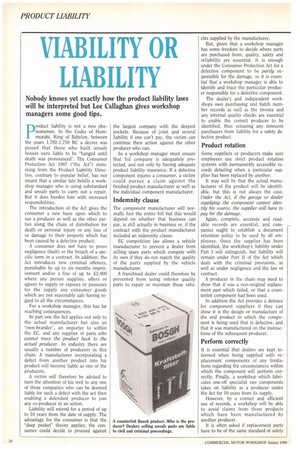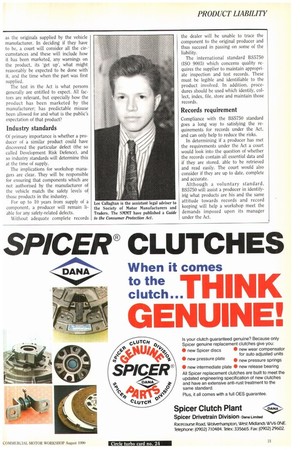VIABILITY OR LIABILITY
Page 100

Page 101

If you've noticed an error in this article please click here to report it so we can fix it.
product liability is not a new phenomenon. In the Codes of Hummurabi, King of Babylon, between the years 1,792-1,750 BC a decree was passed that those who built unsafe houses were liable to be "hanged until death was pronounced". The Consumer Protection Act 1987 ("the Act") stemming from the Product Liability Directive, contrary to popular belief, has not meant that a similar fate befalls a workshop manager who is using substandard and unsafe parts to carry out a repair. But it does burden him with increased responsibilities.
The introduction of the Act gives the consumer a new basis upon which to sue a producer as well as the other parties along the chain of distribution for death or personal injury or any loss of or damage to their property which has been caused by a defective product.
A consumer does not have to prove negligence (fault) or the breach of a specific term in a contract. In addition, the Act introduces new criminal offences, punishable by up to six months imprisonment and/or a fine of up to 12,000 where any person supplies, offers or agrees to supply or exposes or possesses for the supply any consumer goods which are not reasonably safe having regard to all the circumstances.
For a workshop manager, this has far reaching consequences.
In part one the Act applies not only to the actual manufacturer but also an "own-brander", an importer to within the EC, and any supplier of parts who cannot trace the product back to the actual producer. In industry there are usually a number of producers in this chain. A manufacturer incorporating a defect from another product into his product will become liable as one of the producers.
A victim will therefore be advised to turn the attention of his writ to any one of those companies who can be deemed liable for such a defect with the act then enabling a defendant producer to join any co-producer in an action.
Liability will extend for a period of up to 10 years from the date of supply. The advantage for the consumer is that the "deep pocket" theory applies; the consumer could decide to proceed against the largest company with the deepest pockets. Because of joint and several liability if one can't pay, the victim can continue their action against the other producer who can.
So a workshop manager must ensure that his company is adequately protected, and not only by having adequate product liability insurance. If a defective component injures a consumer, a victim could pursue a claim against the finished product manufacturer as well as the individual component manufacturer.
Indemnity clause
The component manufacturer will normally foot the entire bill but this would depend on whether that business can pay, is still actually in business or, if the contract with the product manufacturer included an indemnity clause.
EC competition law allows a vehicle manufacturer to prevent a dealer from selling spare parts which compete with its own if they do not match the quality of the parts supplied by the vehicle manufacturer.
A franchised dealer could therefore be prevented from using inferior quality parts to repair or maintain those vehi cies supplied by the manufacturer.
But, given that a workshop manager has some freedom to decide where parts are purchased from, quality, safety and reliability are essential. It is enough under the Consumer Protection Act for a defective component to be partly responsible for the damage, so it is essential that a workshop manager is able to identify and trace the particular producer responsible for a defective component.
The dealer's and independent workshops own purchasing and batch number records as well as the invoice and any internal quality checks are essential to enable the correct producer to be identified, thus releasing any innocent purchasers from liability for a safety defective product.
Product rotation
Some suppliers or producers make sure employees use strict product rotation systems with permanently accessible records detailing when a particular supplier has been replaced by another.
It may well be that the actual manufacturer of the product will be identifiable, but this is not always the case. Under the Act, if the garage or dealer supplying the component cannot identify his source, the supplier will have to pay for the damage.
Again, complete, accurate and readable records are essential, and companies ought to establish a document retention policy to be used by all employees. Once the supplier has been identified, the workshop's liability under Part I will extinguish, but liability will remain under Part II of the Act which deals with the criminal provisions, as well as under negligence and the law of contract.
A producer in the chain may need to show that it was a non-original replacement part which failed, or that a counterfeit component had been used.
In addition the Act provides a defence for component suppliers if they can show it is the design or manufacture of the end product in which the component is being used that is defective, and that it was manufactured on the instructions of the subsequent producer.
Perform correctly
It is essential that dealers are kept informed when being supplied with replacement components of any limitations regarding the circumstances within which the component will perform correctly. Finally, a workshop which fabricates one-off specialist raw components takes on liability as a producer under the Act for 10 years from its supply.
However, by a correct and efficient use of records, a workshop will be able to avoid claims from those products which have been manufactured by another producer.
It is often asked if replacement parts have to be of the same standard of safety
as the originals supplied by the vehicle manufacturer. In deciding if they have to be, a court will consider all the circumstances and these will include how it has been marketed, any warnings on the product, its 'get up', what might reasonably be expected to be done with it, and the time when the part was first supplied.
The test in the Act is what persons generally are entitled to expect. All factors are relevant, but especially how the product has been marketed by the manufacturer; has predictable misuse been allowed for and what is the public's expectation of that product?
Industry standards
Of primary importance is whether a producer of a similar product could have discovered the particular defect (the so called Development Risk Defence), and so industry standards will determine this at the time of supply.
The implications for workshop managers are clear. They will be responsible for ensuring that components which are not authorised by the manufacturer of the vehicle match the safety levels of those products in the industry.
For up to 10 years from supply of a component, a producer will remain liable for any safety-related defects.
Without adequate complete records thedealer will be unable to trace the component to the original producer and thus succeed in passing on some of the liability.
The international standard BS5750 (ISO 9003) which concerns quality requires the supplier to maintain appropriate inspection and test records. These must be legible and identifiable to the product involved. In addition, procedures should be used which identify, collect, index, file, store and maintain those records.
Records requirement
Compliance with the BS5750 standard goes a long way to satisfying the requirements for records under the Act, and can only help to reduce the risks.
In determining if a producer has met the requirements under the Act a court would look into the question of whether the records contain all essential data and if they are stored, able to be retrieved and read easily. The court would also consider if they are up to date, complete and accurate.
Although a voluntary standard, BS5750 will assist a producer in identifyirig what products are his and the same attitude towards records and record keeping will help a workshop meet the demands imposed upon its manager under the Act.












































































































